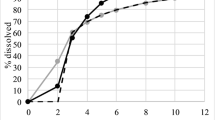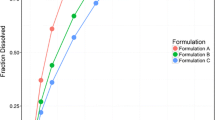Abstract
Purpose. To investigate the ability of an IVIVC developedwith a racemate drug as well as each enantiomer in predicting the invivo enantiomer drug performance.
Methods. Dissolution of metoprolol extended releasetablets with different release characteristics (e.g., fast (F),moderate (M), and slow (S)) was performed using USP ApparatusI, pH 1.2, 50 rpm. Metoprolol racemate tablets (S, M, and F, 100 mg) and 50mg oral solution were administered to healthy volunteers, blood samples werecollected over 24 (solution) and 48 (tablet) hours and assayed. IVIVC modelsdeveloped were: (1) Racemate-fraction of drug dissolved (FRD) vsRacemate-fraction of drug absorbed (FRA), (2) R-FRD vs R-FRA, and (3) S-FRDvs S-FRA for combinations of formulations (S/M/F, S/M, S/F, and M/F).Enantiomer Cmax and AUC prediction errors (PEs) were estimated for modelevaluation after convolution of in vivo release rates.
Results. The R-IVIVC and S-IVIVC accurately predicted theR- and S-metoprolol pharmacokinetic profiles, respectively. The averagedprediciton errors (PE) for the enantiomer Cmax and AUC were less than10% for S/M/F, M/F, and S/F IVIVC models. Racemate-IVIVC (M/F) wasable to predict S-enantiomer with an average %PE of 2.52 for S-Cmaxand 4.3 for S-AUC. However, the racemate-IVIVC was unable to predict theR-enantiomer pharmacokinetic profile.
Conclusions. Metoprolol racemate data cannot be used toaccurately predict R-enantiomer drug concentrations. However, the racematedata was predictive of the active stereoisomer.
Similar content being viewed by others
REFERENCES
Modified Release Solid Oral Dosage Form Guidance: Scale-up and Postapproval Changes: Chemistry, Manufacturing and Controls, In Vitro Dissolution Testing and In Vivo Bioequivalence Documentation. U.S. Department of Health and Human Services, Food and Drug Administration, Center for Drug Evaluation Research (CDER), September 1997.
Guidance for Industry: Extended Release Solid Oral Dosage Form: Development, Evaluation and Application of In Vitro/In Vivo Correlations. U. S. Department of Health and Human Services, Food and Drug Administration, Center for Drug Evaluation Research (CDER), September 1997.
G. T. Tucker and M. S. Lennard. Enantiomer specific pharmacokinetics. Pharmacol. Ther. 45:309–329 (1990).
A. Sandberg, B. Abrahamsson, and C. G. Regardh. Pharmacokinetics of metoprolol enantiomers after administration of racemate and the S-enantiomer as oral solution and extended release tablets. Drug Invest. 6:320–329 (1993).
K. Williams and E. Lee. Importance of drug enantiomers in clinical pharmacology. Drugs 30:333–354 (1985).
H. Y. Aboul-Enein and I. W. Wainer. The impact of stereochemistry on drug development and use. A Wiley-Interscience Publication, John Wiley & Sons, INC. 1997
M. Vakily and F. Jamali. Human Pharmacokinetics of tiaprofenic acid after regular sustained release formulation: Lack of chiral inversion and stereoselective release. J. Pharm. Sci. 83:495–498 (1994).
D. E. Drayer. Pharmacodynamic and pharmacokenetic differences between drug enantiomers in human: An overview. Clin. Pharm. Ther. 40:125–132 (1986).
N. D. Eddington, P. Marroum, R. Uppoor, A. S. Hussain, and L. L. Augsburger. Development and internal validation of an in vitro in vivo correlation for a hydrophilic metoprolol tartrate extended release tablet formulation. Pharm. Res. 15:466–473 (1998).
R. V. Nellore, G. S. Rekhib, A. S. Hussain, L. G. Tillman, H. J. Malinowski, and L. L. Augsburger. Development of metoprolol tartrate extended-release matrix tablet formulations for regulatory policy consideration. J. Controlled Rel. 50:247–256 (1998).
USP XXIII chapter 〈1088〉, United States Pharmacopeial Convention, Inc.; Rockville, Maryland, pp. 1927¶ 1929.
B. Mistry, J. Leslie, and N. D. Eddington. A sensitive assay of metoprolol and its major metabolite α-hydroxy metoprolol in human plasma and determination of dextromethorphan and its metabolite dexthorphan in urine with high performance liquid chromatography and fluorometric detection. J. Pharm. Biomed. Anal. 16:1041–1049(1998)
B. Mistry, J. Wright, J. Leslie, and N. D. Eddington. Direct enantioselective and sensitive high performance liquid chromatographic assay of metoprolol and its two major metabolites in human plasma using chirobiotic T column. Pharm. Res. 14:S685, (1997).
J. W. Moore and H. H. Flanner. Mathematical comparison of curves with an emphasis on dissolution profiles. Pharm Tech. 6:64–74 (1996).
M. S. Lennard, G. T. Tucker, J. H. Silas, S. Freestone, L. E. Ramsay, and H. F. Woods. Differential stereoselective metabolism of metoprolol in extensive and poor debrisoquin metabolizers. Clin. Pharm. Ther. 34:732–737 (1983).
Author information
Authors and Affiliations
Rights and permissions
About this article
Cite this article
Sirisuth, N., Eddington, N.D. Influence of Stereoselective Pharmacokinetics in the Development and Predictability of an IVIVC for the Enantiomers of Metoprolol Tartrate. Pharm Res 17, 1019–1025 (2000). https://doi.org/10.1023/A:1007595725360
Issue Date:
DOI: https://doi.org/10.1023/A:1007595725360




